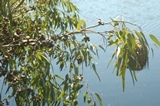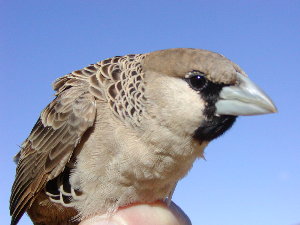Weaver news
| Rat M, van Dijk RE, Covas R, Doutrelant C 2015 Dominance hierarchies and associated signalling in a cooperative passerine. Behavorial Ecology and Sociobiology online.
Introduction. In animal societies, individuals face the dilemma of whether to cooperate or to compete over a shared resource. Two intertwined mechanisms may help to resolve this enduring evolutionary dilemma by preventing conflicts and thereby mediating the costs of living in groups: the establishment of dominance hierarchies and the use of ‘badge-of-status’ for signalling dominance. We investigated these two mechanisms in the sociable weaver (Philetairus socius), a colonial and social passerine which cooperates over multiple tasks. We examined the sociable weavers’ dominance structure in 2 years by recording 2563 agonistic interactions between 152 individuals observed at a feeder at eight colonies. We tested which individual traits, including sex, age, relatedness and two melanin-based plumage traits, predicted variation in social status. First, using social network analysis, we found that colonies were structured by strongly ordered hierarchies which were stable between years. Second, medium-ranked birds engaged more in aggressive interactions than highly ranking individuals, suggesting that competition over food is most pronounced among birds of intermediate social status. Third, we found that colony size and kinship influenced agonistic interactions, so aggression was less pronounced in smaller colonies and among relatives. Finally, within- and between-individual variation in social status and the presence of an individual at the feeder were associated with variation in bib size, as predicted by the badge-of-status hypothesis. These results suggest that dominance hierarchies and bib size mediate conflicts in sociable weaver societies. This study was conducted from Sep 2011-Feb 2013 at Benfontein farm, Northern Cape, South Africa, where long term studies on the Sociable Weaver have been conducted. Adults display two types of melanin-based plumage traits: a black throat patch or bib, and black scaly feathers on both flanks. The black bib was photographed for each individual, and size calculated in the digital photos. The average number of scaly feathers on each flank was counted. Bib patch size, but not mean number of scaly feathers, was correlated with dominance of birds at a feeder. Read more about the Sociable Weaver at Sociable Weaver. Literature as featured in Weaver Watch news items |











